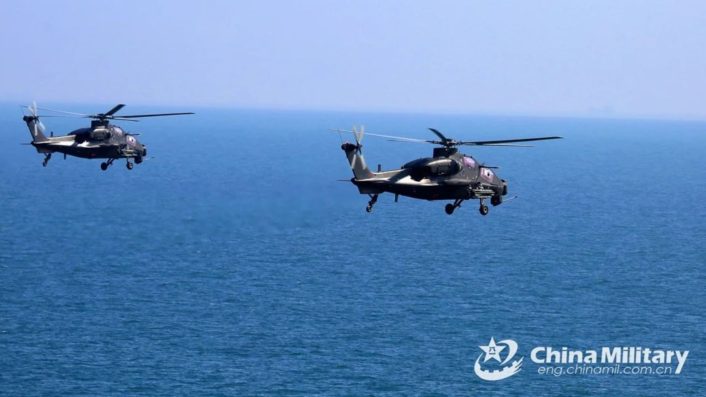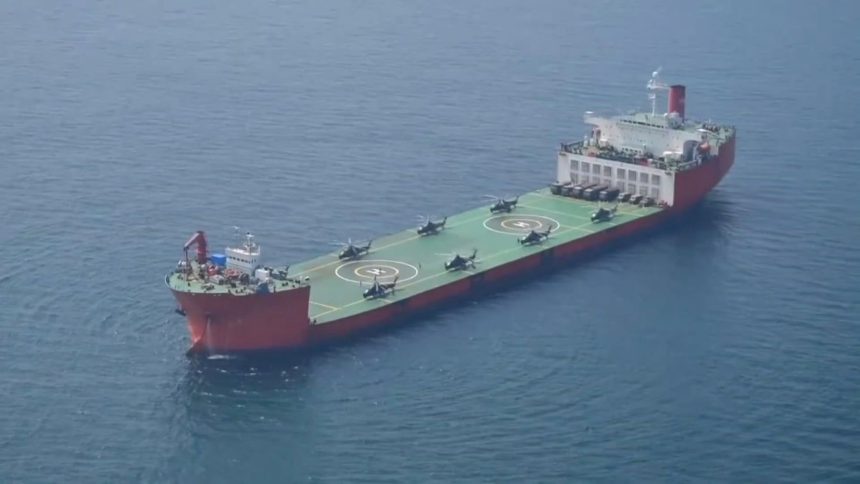In a maritime role in the SCS, the Z-10 would have to travel hundreds of kilometers over the sea, imposing severe time, refueling and logistical constraints to the operational capabilities. A semi-submersible ship would act as a floating base to refuel and rearm the helicopters, allowing them to quickly return to action.
In another display of China’s civil-military fusion for its war efforts, the PLA’s (People’s Liberation Army) Z-10 attack helicopters were shown operating from what appears to be a civilian semi-submersible ship. The vessel is usually employed to transport oil and gas exploration platforms.
The Z-10, the mainstay of China’s medium-weight attack helicopter fleet, is likely to be used in all scenarios even after the heavier Z-21 helicopter enters service. Previous pictures and the latest images reposted by Chinese military tracker Jesus Roman on X now indicate the Z-10 might also have a maritime role.
The image and the short GIF clip show eight Z-10s with their rotors running and ready to take off from the flat deck of the semi-submersible ship, which appears to be used as an “offshore relay platform.” According to some reports, this was part of an exercise to test the PLA’s capability to conduct operations even when traditional platforms are not available.
The goal of the exercise was the simulation of an amphibious assault with the helicopters operating from the floating base. As it can be seen in the picture and video, the semi-submersible ship is also seen carrying trucks and other vehicles, allowing refueling and rearming of the Z-10s for an expeditionary capability.
The Z-10 has been assessed to have a considerable role in a possible invasion of Taiwan. The Aviationist reported in early August 2024 about a PLA Z-10 seen flying over the sea with a KG300G EW (Electronic Warfare) pod under the left stub wing. The helicopter was flying alongside a Russian-made Mi-8 helicopter.
Previous Chinese reports claimed Z-10s with the 73rd Group Army of the Eastern Theater Command undertook “day-and-night live-fire drills off the east coast of the Fujian province.” The helicopters “took off in formation and headed toward designated areas, avoiding radar detection attempts through evasive maneuvers and low altitude flights and successfully launching attacks on maritime targets and targets on islands and reefs,” Global Times said.
In May 2022, The War Zone reported that a Z-10 entered Taiwan’s ADIZ (Air Defense Identification Zone) for the first time. Global Times, however, claimed the Z-10’s first incursion into Taiwanese ADIZ happened on Oct. 19, 2021.
8x Z-10 attack helicopters from the 🇨🇳PLAGF Aviation during an exercise ready to take off using the deck of a semi-submersible transport vessel as offshore relay platform
(via wb/沉默的山羊 & 枕戈观澜) pic.twitter.com/XJMY6JSC8i
— Jesus Roman (@jesusfroman) October 19, 2024
Use in a Taiwan invasion
As explained in previous analyses on the military-tactical dynamics of possible invasion of Taiwan, China relies on a multiplicity of diverse aerial, land, naval, unmanned systems in independent yet mutually supporting roles. Such invasion would first begin with a sudden and multi-directional air and naval blockade to overwhelm the island’s leadership and present them with a fait accompli, given how many Chinese exercises continue to surround the island.
If hostilities erupt, these systems would be possibly used to simultaneously strike Taiwan’s military bases and air stations all around the island. Attack helicopters would be on the frontlines if the PLA was to launch an amphibious assault, providing cover for troops on the ground as they face Taiwanese beach head defenses.
The helicopters would provide continuous fire support against tactical targets, where long-range precision strikes might be outsized. This is where a floating base such as the semi-submersible ship would become very useful, as helicopters would be able to refuel and rearm much closer area of operations and return to combat faster.

Maritime role and defending island bases
It wouldn’t be far-fetched to imagine that China might use these attack helicopters to defend its militarized bases of the Paracel and Spratly Islands in the central and southern part of the SCS (South China Sea). The U.S. Marine Corps has envisioned its AH-1Z Viper undertaking light, disabling strikes against Chinese vessels. Its Force Design 2030 and EABO (Expeditionary Advanced Base of Operations) concepts envisage undertaking anti-shipping and land-strike roles on PLA Navy warships and islands bases with NSM (Naval Strike Missile) and the HIMARS (High Mobility Artillery Rocket System).
Small, nimble and highly mobile teams would undertake these “Long Range Fires” from islands controlled by friendly nations with a view to spread out and fight China inside its A2/AD (Anti-Access/Area-Denial Bubble). Both the Taiwan and the SCS scenarios would need the Z-10 to take off from land and travel hundreds of kilometers into the sea, imposing severe time and logistical constraints.
The need for submersible ships’ would be even more acute when the Changbaishan, Type 075, the under-construction Type 076-class LHD (Landing Helicopter Dock) amphibious landing ships would be engaged in taking Taipei.
Nice images released by China Military of joint training exercise held by PLA Army & Navy in February.
Z-10 attack helicopter landing on Type-071 amphibious ship. Mil Mi 17 transport helicopters in formation with Z-10. #Jointness pic.twitter.com/V9ZZNAJx1C
— ST (@aviation07101) March 19, 2021
This supports persistent tactical maritime surveillance-strike roles when the entire western Pacific theater comprising the three flashpoints of the Korean Peninsula, the Taiwan Strait and the South China Sea are up in flames. The tactic fills in the gaps and unburdens the PLA Navy’s Shaanxi KQ-200/Y-8 MPAs (Maritime Patrol Aircraft) which would be engaged in theater-wide surveillance.
China’s civilian fleet for naval roles
China has long displayed employing its civilian merchant, passenger and fishing boats for military use, for logistical unburdening, tactical flexibility and possessing diverse platforms undertaking combat support or secondary and tertiary maritime warfare roles.
Its fleet of civilian RoRo (Roll-On Roll-Over) vessels have figured in multiple exercises taking in several dozen tanks, armor and military trucks and hundreds of troops, in what is assessed to be a preparation for the landing of ground forces on Taiwan’s western shores during amphibious assaults.
🔻 Chinese military movements: PLA tanks disembarking from Bohai Baozhu (渤海宝珠) RO-RO / passenger ship and then boarding a train for further transportation (unknown location / date) pic.twitter.com/9Pv0zVuSFP
— Byron Wan (@Byron_Wan) July 30, 2022
Its fishing vessels meanwhile, which are notorious for appearing in swarms in disputed sea regions with Japan and the Philippines, are officially described and recognized as the PAFMM (People’s Armed Forces Maritime Militia) in China’s defense white papers. They appear to have more maritime claims enforcement and military-logistical roles than core combat roles.
The use of the semi-submersible vessel is therefore consistent with this practice. It could also be the case that the semi-submersible is not permanently assigned to the PLA or PLA Navy, as it would have received relevant markings and paint schemes, similarly to Iranian tankers converted for naval use.
HERE WE GO AGAIN: #Chinese “maritime militia” vessels surround #Philippines Navy ship BRP Datu Tamblot and Philippine fishing boats during a mission to bring supplies and assistance to fishermen in Scarborough Shoal in the disputed #SouthChinaSea on February 16, 2024.
Via… pic.twitter.com/OmYlppt22N
— Indo-Pacific News – Geo-Politics & Defense (@IndoPac_Info) February 19, 2024









